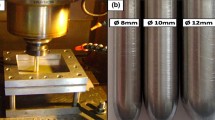Abstract
Establishing a non-uniform thickness section is considered one of the most effective approaches to reduce automotive part weight. Low weight results in low fuel consumption, which is good for the environment. Thickness is the most significant parameter to formability; therefore, forming a section with non-uniform thickness becomes a great challenge. An incorrect decision may result in a severe defect, and one of the main concerns is springback. This study focuses on the springback behavior of AA6061 strip with non-uniform thickness using the Taguchi method. Three parameters (i.e., thickness ratio, bend angle, and alignment) are studied, and results determine that the most significant parameter is bend angle, followed by thickness ratio, and then by the alignment of the specimen during the bending process.
Similar content being viewed by others
References
Kleiner M, Geiger M, Klaus A (2003) Manufacturing of lightweight components by metal forming. CIRP Ann - Manuf Technol 52:521–542
Jeya Girubha R, Vinodh S (2012) Application of fuzzy VIKOR and environmental impact analysis for material selection of an automotive component. Mater Des 37:478–486
Mayyas A, Qattawi A, Omar M, Shan D (2012) Design for sustainability in automotive industry: a comprehensive review. Renew Sustain Energy Rev 16:1845–1862
Joost WJ (2012) Reducing vehicle weight and improving U.S. energy efficiency using integrated computational materials engineering. JOM 64:1032–1038
Ghassemieh E (2010) Materials in automotive application, state of the art and prospects., pp 365–394
California Air Resources Board, Lutsey N (2010) Review of technical literature and trends related to automobile mass-reduction technology
Davis UC (2010) Institute of Transportation Studies review of technical literature and trends related to automobile mass-reduction technology UCD-ITS-RR-10-10
Zhang Q, Liu Y, Zhang Z (2016) A new optimization method for sheet metal forming processes based on an iterative learning control model. Int J Adv Manuf Technol 85:1063–1075
Fu Z, Mo J (2011) Springback prediction of high-strength sheet metal under air bending forming and tool design based on GA–BPNN. Int J Adv Manuf Technol 53:473–483
Tao YR, Duan SY, Cao L, Jiang B (2014) A novel sheet metal forming technology to enhance formability of FVS0812 sheet. Int J Adv Manuf Technol 74:859–866
Merklein M, Opel S (2012) Investigation of tailored blank production by the process class sheet bulk metal forming. AIP Conf Proc 1315:395–400
Merklein M, Johannes M, Lechner M, Kuppert A (2014) A review on tailored blanks—production, applications and evaluation. J Mater Process Technol 214:151–164
Merklein M, Lechner M (2013) Manufacturing flexibilisation of metal forming components by tailored blanks. In: Dimitrov D, Schutte C (eds) Proc. conf. competitive manufacturing., pp 165–170
Veera Babu K, Ganesh Narayanan R, Saravana Kumar G (2010) An expert system for predicting the deep drawing behavior of tailor welded blanks. Expert Syst Appl 37:7802–7812
Kashani HT, Kah P, Martikainen J (2015) Laser overlap welding of zinc-coated steel on aluminum alloy. Phys Procedia 78:265–271
Zhang H (2012) Springback characteristics in U-channel forming of tailor rolled blank. Acta Metall Sin 25:207–213
Mori K, Abe Y, Osakada K, Hiramatsu S (2011) Journal of materials processing technology plate forging of tailored blanks having local thickening for deep drawing of square cups. J Mater Process Tech 211:1569–1574
Meyer AÃ, Wietbrock B, Hirt G (2008) Increasing of the drawing depth using tailor rolled blanks—numerical and experimental analysis. Int J Machine Tools and Manufacture 48:522–531
Aziz N, Bashah K, Muhamad N, Deros B, Zakaria A, Ashari S, Mobin A, Abdul-Lazat MSM (2013) Multi-regression modeling for springback effect on automotive body in white stamped parts. Mater Des 46:175–190
Burchitz I (2005) Springback: improvement of its predictability: literature study report
Yoshida T, Isogai E, Sato K, Hashimoto K (2013) Springback problems in forming of high-strength steel sheets and countermeasures. Nippon Steel Technical Report 103:4–10
Eggertsen PA, Mattiasson K (2012) Experiences from experimental and numerical springback studies of a semi-industrial forming tool. Int J Mater Form 5:341–359
Lee SW, Kim Y-T (2007) A study on the springback in the sheet metal flange drawing. J Mater Process Technol 187–188:89–93
Dezelak M, Stepisnik A, Pahole I (2014) Evaluation of twist springback prediction after an AHSS forming process. Int J Simul Model 13:171–182
Li H, Sun G, Li G, Gong Z, Liu D, Li Q (2011) On twist springback in advanced high-strength steels. Mater Des 32:3272–3279
Xu F, Tian X, Li G (2015) Experiment study on crashworthiness of functinally graded thickness thin-walled tubular struture. Exp Mech 55:1339–1352
Hirsch J (2014) Recent development in aluminium for automotive applications. Trans Nonferrous Met Soc China 24:1995–2002
Kamaruddin S, Khan ZA, Foong SH (2010) Application of Taguchi method in the optimization of injection moulding parameters for manufacturing products from plastic blend. Int J Eng Technol 2:574–580
Kuo CFJ, Su TL, Tsai CP (2007) Optimization of the needle punching process for the nonwoven fabrics with multiple quality characteristics by grey-based Taguchi method. Fibers Polym 8:654–664
Thipprakmas S, Phanitwong W (2011) Process parameter design of spring-back and spring-go in V-bending process using Taguchi technique. Mater Des 32:4430–4436
Selvakumar N, Narayanasamy R (2005) Experimental investigation of strain hardening behaviour of sintered aluminium preforms. Trans Indian Inst Met 58:787–799
Dwivedi JP, Shah SK, Upadhyay PC, Das Talukder NK (2002) Springback analysis of thin rectangular bars of non-linear work-hardening materials under torsional loading. Int J Mech Sci 44:1505–1519
Abdullah AB, Samad Z (2013) An experimental investigation of springback of AA6061 aluminum alloy strip via V-bending process. IOP Conf Ser Mater Sci Eng 50:012069
Yang WH, Tarng YS (1998) Design optimization of cutting parameters for turning operations based on the Taguchi method. J Mater Process Technol 84:122–129
Author information
Authors and Affiliations
Corresponding author
Rights and permissions
About this article
Cite this article
Adnan, M.F., Abdullah, A.B. & Samad, Z. Springback behavior of AA6061 with non-uniform thickness section using Taguchi Method. Int J Adv Manuf Technol 89, 2041–2052 (2017). https://doi.org/10.1007/s00170-016-9221-0
Received:
Accepted:
Published:
Issue Date:
DOI: https://doi.org/10.1007/s00170-016-9221-0




